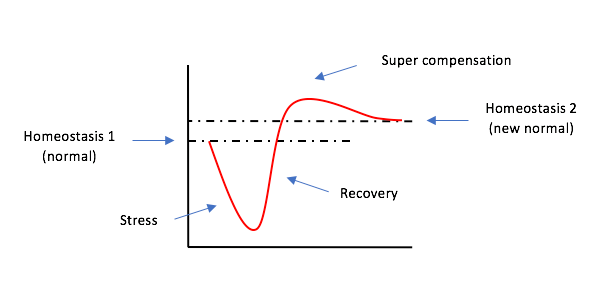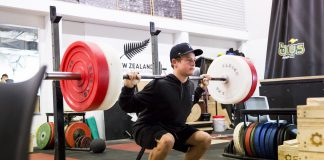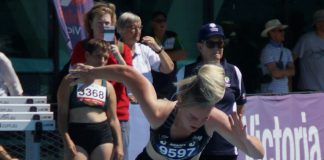How do you know how much sport is too much?
How do you know that all the training you’re doing isn’t doing more harm than good?
It’s easy to think that more is better. That because you’re out there working hard on your endurance, you must be getting fitter. Or that because you’re putting so much time in practicing your shooting skills, you’re improving”.
Unfortunately, it’s not that simple.
Think back to your last early morning training. Did you battle to drag yourself out of bed when your alarm went off? When you finally turned up, late, could you not stop yawning? And how was your mood? Did you get frustrated easily? Did you find yourself giving up when and extra bit of effort was called for? You know, that extra 10% we know makes all the difference in training.
Adaptation is the change your body makes in response to training stress. It’s the driving force behind you getting better.
A healthy body (i.e. one that isn’t tired, or hungry, or sore) is one that maintains homeostasis – I know it’s a big word but stay with me. You can think of homeostasis as the body’s normal range in which is stays healthy and functions optimally.
Training is a form of physiological load that puts stress on the body. Think about the thumping sensation you get in your chest when your heart rate responds to a hard-out fitness session. Or that burning feeling in your legs when your sprint as fast as you can up a steep hill.
Despite feeling uncomfortable at the time, physiological stress is vital in your training. It’s what forces your body to adapt to get fitter, stronger, or more skilled. It puts you into a fatigued state, which signals a repair response from the body and the start of recovery process.

Figure 1. The Super-Compensation Model
To produce the outcome you’re after, the right kind of training stress is required.
If your goal is to maintain a high intensity throughout the entire game, you need to stress the cardiovascular system using appropriate duration and frequency. If you goal is to jump higher, your muscular system requires stress. And if you want to become more skilful, then your sensorimotor system must be stressed through deliberate practice.
All going well, the body adapts and ‘super compensates’ to a higher point of homeostasis – your body’s normal range in increased and you get better.
But it’s not all about training stress.
Other types of stress must also be accounted for, such as the stress of exams and assessments at school, the stress of family and social relationships, and the stress of a part time job, if you want to improve.
Crucially, stress is cumulative. Stress at home, school, work and training add up and contribute to overall fatigue. And the more fatigued you are, the more time you need to recover from training, adapt, and ultimately, super compensate.
So, how do you get it right?
Measure Your Training Load
Measuring training load gives you a sense for how ready you are to train and compete. It also helps you change something that isn’t working.
Here’s how to measure your training load, and use it to modify your training appropriately, in 6 easy steps.
1) Record how long you train
Record the duration of each training or game in minutes.
2) Score your training effort
How much effort are you giving in training? The second step is to monitor your effort after a session.
The scale of perceived effort (table 1) describes a range of exercise intensities, from nothing at all, to as hard as you can go, and assigns a score to them. For example, if scoring the game you played last weekend during which you were struggling to keep up with the pace, you’d give it an 8.
| Score | Perceived Effort |
| 0 | Rest – nothing at all, like you’re sitting on the couch |
| 1 | Super easy, like a slow walk |
| 2 | Easy – you can have go on for a long time |
| 3 | Moderate |
| 4 | Somewhat hard – you’re a bit stuff at the end |
| 5 – 6 | Hard – you were keeping up but feeling it |
| 7 – 8 | Very hard – you were struggling to up |
| 9 | Very, very hard – almost as hard as you could possibly go |
| 10 | Maximal – as hard as you’ve ever gone in your life |
Table 1. Scale of Perceived Effort
3) Calculate your session training load
Your session training load is training duration X your effort score. For example, if you train for 60 minutes at an effort of 5, your training load for that session will be 300. Do this for every session you complete during the week.
4) Calculate your daily training load points
Your daily training load is the total of your session training load scores. Do this for each day of the week.
5) Compute you weekly training load points
Your weekly training load is the total of your daily training load scores.
| Monday | Tuesday | Wednesday | Thursday | Friday | Saturday | Sunday | |
|
Training session/game duration and effort score
|
Run – 45 x 7 = 315 |
hockey training – 90 x 6 = 540 |
swimming training – 60 x 5 = 300 | Run – 30 x 6 = 180
hockey training – 45 x 4 = 180 |
Rest | hockey game – 60 x 8 = 480 | water polo game – 20 x 4 = 80 |
| Total points for the day | 315 | 540 | 300 | 360 | 480 | 80 | |
| Total points for the week | 2, 075 | ||||||
Table 2. Example weekly training load for a 14-year-old hockey player
6) Monitor how you feel
Now that you’ve quantified how much you are doing as an arbitrary number per week, you must interpret it with a view to changing anything that’s not working.
You can accomplish this by sitting down on a Sunday afternoon and reflecting on the past week by asking yourself 5 simple questions.
- How have I been feeling mentally?
- How have I been feeling physically?
- How am I sleeping?
- How hungry am I?
Answering these questions will give you a sense of the volume of training that is right for you.
For instance, if you are mentally drained, or physically sore a lot, you may need to dial down your training and make room for more recovery. If you’re struggling to get out of bed in the morning, try and schedule more sleep. And if you are battling with sleep quality (i.e., you find it hard to get to sleep at night and/or wake up a lot), or you’re constantly low on appetite, it’s highly likely you’re over doing it.
Download your FREE Training Load Monitoring Template here
Do this for every week you train. Over time, and based on where you’re at in your season, you’ll experience a range of weekly training loads you can use to learn about yourself. You may also find it helps you answer important questions, like “how much is too much?”
Be the best you can be,
P.S. I’d love to know how you go, so please let me know in the comments below.




































